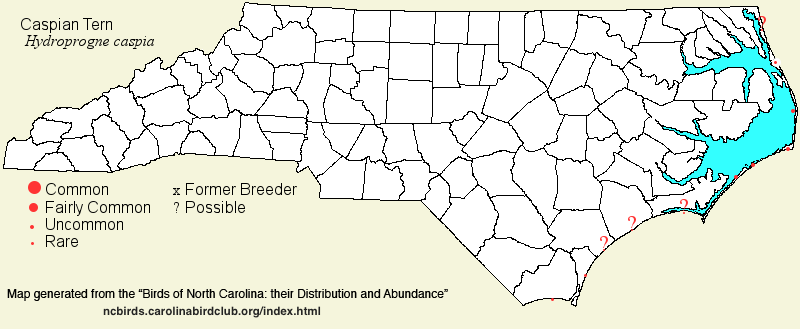 |  |
|
Caspian Tern - Hydroprogne caspia LARIDAE Members: | Search Common: Search Scientific: |
|
|
|||||||
| General Comments | The Caspian Tern is the largest tern in the world, and it is also one of the most wide-ranging, as it breeds both in the New World and in the Old World. It has a bizarre breeding range in North America; it nests both on inland lakes and marshes in the interior as well as on the Atlantic, Pacific, and Gulf coasts. The Atlantic coast population is very small and consists mainly of small colonies from Virginia to South Carolina; in North Carolina, an average of only 10-20 pairs nest each year, essentially only in Oregon Inlet and sparingly in Hatteras Inlet. Birds nest on sand islands with Royal and Sandwich terns; however, in the breeding season, Caspians forage mainly at fresh and brackish impoundments and marshes, leaving the salt water habitats to the Royal and Sandwich terns. Interestingly, at other seasons, Caspians forage more widely, and often occur in estuaries and sounds, but it seldom is found over the ocean. Because it nests well inland in North America, migrants do pass through the inland parts of the state in both spring and fall, and it is one of the more "numerous" terns seen on lakes -- though still a relatively good find for birders inland. | ||||||
| Breeding Status | Breeder | ||||||
| NC BRC List | Definitive | ||||||
| State Status | T | ||||||
| U.S. Status | |||||||
| State Rank | S2B,S1N | ||||||
| Global Rank | G5 | ||||||
| Coastal Plain | Permanent resident (and sparse breeder), with migratory movements, along the coast; transient inland. Along the coast, fairly common to at times common fall migrant, but mostly uncommon to locally fairly common in spring; in winter, formerly uncommon, but now rare (at least by midwinter), along the extreme southern coast (New Hanover and Brunswick), but very rare farther northward, and essentially absent on the northern coast. However, one spent nearly the entire winter at Cape Hatteras Point (Dare), found 8 Jan 2022 and seen into Mar. As a breeder, generally rare to uncommon, essentially only in the northern areas of the coast, mainly close to Oregon and Hatteras inlets. Tidewater and far inland areas: mostly a spring and fall migrant, generally uncommon at both seasons, at larger lakes and reservoirs; small numbers can be seen in summer in the Tidewater areas, such as at Lake Phelps, but no known local breeding. Numbers begin arriving in mid-Aug and declining by early Nov, with a peak from late Aug to late Sep; return flights mainly mid-Apr to mid-May. Peak counts: 275, Lake Mattamuskeet, 25 Oct 2009; 148, New River Inlet (Onslow), 29 Sep 2015; 123, Mason Inlet (New Hanover), 26 Sep 2015; 105, east end of Sunset Beach (Brunswick), 4 Oct 2014; 100, Oregon Inlet, 5 Oct 1977. | ||||||
| Piedmont | Transient. Uncommon though regular in both spring and fall at larger lakes/reservoirs, but very rare elsewhere. Mainly from mid-Apr to mid-May, and late Aug to late Sep, but scattered records in Jun and Jul; casually from mid-Mar to the end of Oct. One at Lake Crabtree (Wake) was quite late on 8 Nov 2017; one seen at Jordan Lake (Chatham) was a very rare winter record on 5 Jan 2025. Peak counts: 74, Jordan Lake, 22 Apr 2018; 54, Falls Lake, 20 Apr 1997; 45, Jordan Lake, 16 Apr 2000; 45, Jordan Lake, 26 Apr 1998. | ||||||
| Mountains | Transient. Rare, in the southern mountains only (Buncombe, Haywood, Henderson, and Transylvania). The roughly 20 records fall between 2 Apr and 14 May, and 22 Aug to 22 Sep, with out-of-season records on 6 Jun, 18 Jun, and 21 Jun and another on 4 Nov. Peak count: 4, Lake Julian, 19-21 Apr 2006; 4, at this lake, 6 Sep 2017; 4, Ecusta Pond (Transylvania), 14 May 2024; 2, on several dates. | ||||||
| Finding Tips |
Caspian Terns can usually be found along most coastal areas in late summer and fall, especially around impoundments. In early winter, the Fort Fisher area is the most accessible site for them, and in the breeding season your best bet is at Oregon Inlet and Pea Island. They are erratic in migration at the larger reservoirs, but each spring and fall some do occur at most of the larger lakes. *** | ||||||
| Attribution | LeGrand[2025-10-20], LeGrand[2025-05-08], LeGrand[2025-04-21] | ||||||
| NC Map Map depicts all counties with a report (transient or resident) for the species. | Click on county for list of all known species. |
| NC Breeding Season Map Map depicts assumed breeding season abundance for the species. |  |